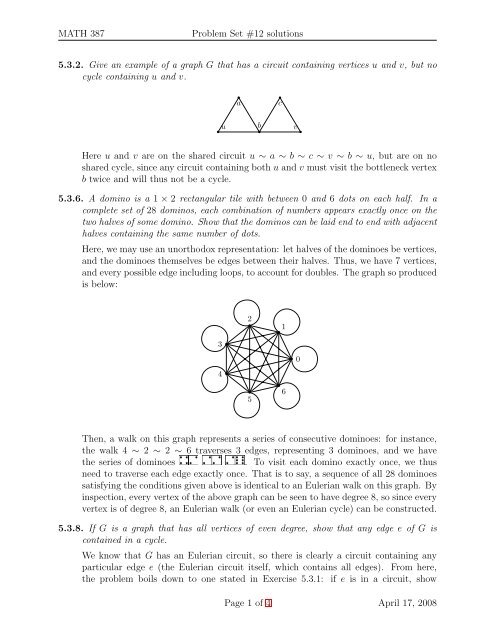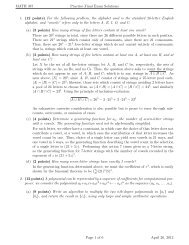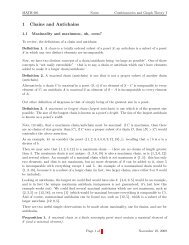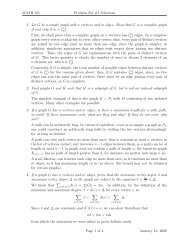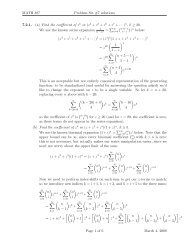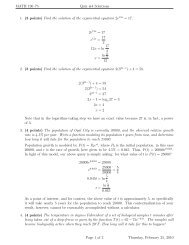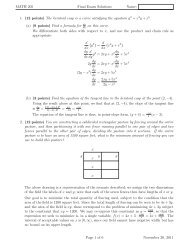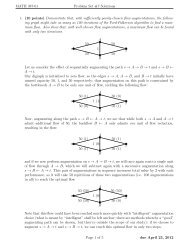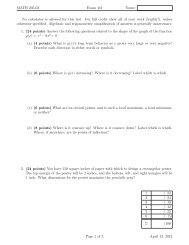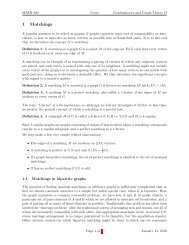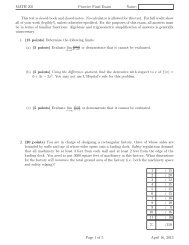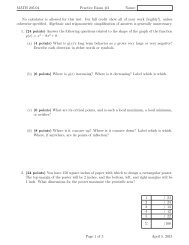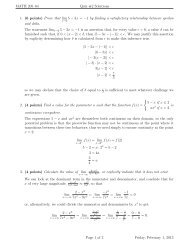MATH 387 Problem Set #12 solutions 5.3.2. Give an example of a ...
MATH 387 Problem Set #12 solutions 5.3.2. Give an example of a ...
MATH 387 Problem Set #12 solutions 5.3.2. Give an example of a ...
You also want an ePaper? Increase the reach of your titles
YUMPU automatically turns print PDFs into web optimized ePapers that Google loves.
<strong>MATH</strong> <strong>387</strong><br />
<strong>Problem</strong> <strong>Set</strong> <strong>#12</strong> <strong>solutions</strong><br />
<strong>5.3.2.</strong> <strong>Give</strong> <strong>an</strong> <strong>example</strong> <strong>of</strong> a graph G that has a circuit containing vertices u <strong>an</strong>d v, but no<br />
cycle containing u <strong>an</strong>d v.<br />
a<br />
c<br />
u<br />
b<br />
v<br />
Here u <strong>an</strong>d v are on the shared circuit u ∼ a ∼ b ∼ c ∼ v ∼ b ∼ u, but are on no<br />
shared cycle, since <strong>an</strong>y circuit containing both u <strong>an</strong>d v must visit the bottleneck vertex<br />
b twice <strong>an</strong>d will thus not be a cycle.<br />
5.3.6. A domino is a 1 × 2 rect<strong>an</strong>gular tile with between 0 <strong>an</strong>d 6 dots on each half. In a<br />
complete set <strong>of</strong> 28 dominos, each combination <strong>of</strong> numbers appears exactly once on the<br />
two halves <strong>of</strong> some domino. Show that the dominos c<strong>an</strong> be laid end to end with adjacent<br />
halves containing the same number <strong>of</strong> dots.<br />
Here, we may use <strong>an</strong> unorthodox representation: let halves <strong>of</strong> the dominoes be vertices,<br />
<strong>an</strong>d the dominoes themselves be edges between their halves. Thus, we have 7 vertices,<br />
<strong>an</strong>d every possible edge including loops, to account for doubles. The graph so produced<br />
is below:<br />
2<br />
1<br />
3<br />
0<br />
4<br />
5<br />
6<br />
Then, a walk on this graph represents a series <strong>of</strong> consecutive dominoes: for inst<strong>an</strong>ce,<br />
the walk 4 ∼ 2 ∼ 2 ∼ 6 traverses 3 edges, representing 3 dominoes, <strong>an</strong>d we have<br />
the series <strong>of</strong> dominoes ¨¦ ¦¦ ¦Å. To visit each domino exactly once, we thus<br />
need to traverse each edge exactly once. That is to say, a sequence <strong>of</strong> all 28 dominoes<br />
satisfying the conditions given above is identical to <strong>an</strong> Euleri<strong>an</strong> walk on this graph. By<br />
inspection, every vertex <strong>of</strong> the above graph c<strong>an</strong> be seen to have degree 8, so since every<br />
vertex is <strong>of</strong> degree 8, <strong>an</strong> Euleri<strong>an</strong> walk (or even <strong>an</strong> Euleri<strong>an</strong> cycle) c<strong>an</strong> be constructed.<br />
5.3.8. If G is a graph that has all vertices <strong>of</strong> even degree, show that <strong>an</strong>y edge e <strong>of</strong> G is<br />
contained in a cycle.<br />
We know that G has <strong>an</strong> Euleri<strong>an</strong> circuit, so there is clearly a circuit containing <strong>an</strong>y<br />
particular edge e (the Euleri<strong>an</strong> circuit itself, which contains all edges). From here,<br />
the problem boils down to one stated in Exercise 5.3.1: if e is in a circuit, show<br />
Page 1 <strong>of</strong> 4 April 17, 2008
<strong>MATH</strong> <strong>387</strong><br />
<strong>Problem</strong> <strong>Set</strong> <strong>#12</strong> <strong>solutions</strong><br />
that it must be in a cycle. Let us call the endpoints <strong>of</strong> e by the names u <strong>an</strong>d v, so<br />
our Euleri<strong>an</strong> circuit includes the step u ∼ v representing its passage along e. Now<br />
let us consider the continuation <strong>of</strong> the circuit from here, along labeled points w i :<br />
u ∼ v = w 0 ∼ w 1 ∼ · · · ∼ w k−1 ∼ w k = u. If this circuit is a cycle, we’re done.<br />
If not, then there must be a self-intersection w i = w j , in which case we simply drop<br />
the cycle-section between i <strong>an</strong>d j <strong>an</strong>d continue with the new circuit:<br />
u ∼ v = w 0 ∼ w 1 ∼ · · · ∼ w i−1 ∼ w i ∼ w j ∼ w j+1 ∼ · · · ∼ w k−1 ∼ w k = u<br />
We repeat this procedure until we have a cycle, which is guar<strong>an</strong>teed to happen eventually,<br />
since the circuit only has finitely m<strong>an</strong>y vertices <strong>an</strong>d hence only finitely m<strong>an</strong>y<br />
self-intersections.<br />
5.3.10. (a) A mythical chess piece is allowed to move one square vertically or one square<br />
horizontally. Show that it is not possible to move from one corner <strong>of</strong> <strong>an</strong> 8 × 8<br />
chessboard <strong>an</strong>d visit each square exactly once, ending at the diagonally opposite<br />
corner.<br />
This question is identical to finding a Hamiltoni<strong>an</strong> path from the lower left corner<br />
to the upper right on a graph in which board positions are vertices on a graph<br />
<strong>an</strong>d edges are valid moves. However, the problem c<strong>an</strong> also be solved in a more<br />
intuitive way: each move is between squares <strong>of</strong> different colors, according to the<br />
usual coloring <strong>of</strong> the chessboard. We start in one corner <strong>an</strong>d have 63 other squares<br />
to visit, so we must make 63 moves. After doing so, we will have ch<strong>an</strong>ged color<br />
63 times, so our final position must be a square <strong>of</strong> opposite color to the one we<br />
started on. However, opposite corners <strong>of</strong> the chess board are the same color.<br />
(b) A knight’s move on a chessboard starts by first going two squares horizontally or<br />
vertically <strong>an</strong>d ends by going one square perpendicularly. Is it possible to move a<br />
knight on <strong>an</strong> 8 ×8 chessboard so that it completes every move exactly once, where<br />
a move between two squares is said to be completed when it is made in either<br />
direction?<br />
This question is identical to finding <strong>an</strong> Euleri<strong>an</strong> path on a graph in which board<br />
positions are vertices on a graph <strong>an</strong>d edges are valid knight’s-moves. Such a graph<br />
is shown below:<br />
While this graph is rather a mess, the most signific<strong>an</strong>t feature is the degree at<br />
each point (that is, the number <strong>of</strong> valid knight’s-moves from that point. In the<br />
middle <strong>of</strong> the board, where the knight has free motion, there are 6 valid moves,<br />
Page 2 <strong>of</strong> 4 April 17, 2008
<strong>MATH</strong> <strong>387</strong><br />
<strong>Problem</strong> <strong>Set</strong> <strong>#12</strong> <strong>solutions</strong><br />
<strong>an</strong>d these points have degree <strong>of</strong> 6; points in the corner, on the other h<strong>an</strong>d, only<br />
admit two possible moves <strong>an</strong>d thus these points c<strong>an</strong> be seen to have degree <strong>of</strong><br />
2. In particular, as pertains to Euleri<strong>an</strong> paths, we are particularly curious as to<br />
whether there are points <strong>of</strong> odd degree, <strong>an</strong>d one c<strong>an</strong> indeed find several: the 8<br />
points one step away from the corners <strong>of</strong> the board (emphasized in the graph<br />
above with slightly heavier-weight dots), for inst<strong>an</strong>ce, have degree <strong>of</strong> 3. Since<br />
there are more th<strong>an</strong> two vertices <strong>of</strong> odd degree, <strong>an</strong> Euleri<strong>an</strong> path through this<br />
graph is not possible.<br />
5.3.12. Two cycles in a graph are said to be the same if they consist <strong>of</strong> the same cyclic<br />
rotation <strong>of</strong> vertices, whether or not they start at the same vertex.<br />
(a) Count the number <strong>of</strong> different Hamiltoni<strong>an</strong> cycles in the complete graph K n .<br />
Let us label the vertices <strong>of</strong> K n as u 1 , u 2 , u 3 , . . . , u n . Since a Hamiltoni<strong>an</strong> cycle<br />
visits every vertex <strong>of</strong> the graph, we know it must visit u 1 ; let us arbitrarily define u 1<br />
as the “start” vertex, so as to not count the same cycle starting in different places<br />
multiple times. Since we have complete freedom <strong>of</strong> movement, a Hamiltoni<strong>an</strong><br />
cycle is simply <strong>an</strong> ordering <strong>of</strong> the vertices u 1 ∼ u i2 ∼ u i3 ∼ u i4 ∼ · · · ∼ u in ∼ u 1 .<br />
Every arr<strong>an</strong>gement <strong>of</strong> 2, 3, 4,...,n into i 2 ,i 3 ,i 4 ,...,i n c<strong>an</strong> be assembled into a<br />
path, since every possible edge is present in the complete graph. Thus, we have<br />
(n −1)! different paths arising therefrom. The statement <strong>of</strong> this problem is vague<br />
on whether reversals <strong>of</strong> the vertex order is also considered identical, e.g. whether<br />
u 1 ∼ u 2 ∼ u 3 ∼ · · · ∼ u n ∼ u 1 is the same path as u 1 ∼ u n ∼ u n−1 ∼ u n−2 ∼<br />
· · · ∼ u 2 ∼ u 1 ; if you hold to this viewpoint, then we have actually counted every<br />
cycle twice with the above construction, so we would have (n−1)!<br />
2<br />
cycles instead.<br />
(b) Count the number <strong>of</strong> different Hamiltoni<strong>an</strong> cycles in the complete bipartite graph<br />
K n,n .<br />
As above, let us name the vertices in the two parts, with distinctive names for each<br />
part, for inst<strong>an</strong>ce, u 1 ,...,u n <strong>an</strong>d v 1 ,...,v n . As above, we know a Hamiltoni<strong>an</strong><br />
cycle visits u 1 , so we c<strong>an</strong> fix u 1 as the start vertex. In this case we know a<br />
Hamiltoni<strong>an</strong> cycle consists <strong>of</strong> distinct vertices picked alternatingly from the u i<br />
<strong>an</strong>d the v i ; e.g. u 1 ∼ u 2 would be <strong>an</strong> inappropriate step in a Hamiltoni<strong>an</strong> cycle<br />
because edges only go between the parts, not among a single part. Thus, a<br />
prototypical Hamiltoni<strong>an</strong> cycle in this graph would be<br />
u 1 ∼ v i1 ∼ u j2 ∼ v i2 ∼ u j3 ∼ · · · ∼ u jn−1 ∼ v jn−1 ∼ u in ∼ v jn ∼ u 1<br />
where i 1 ,...,i n c<strong>an</strong> be <strong>an</strong>y ordering <strong>of</strong> 1,...n, <strong>an</strong>d j 2 ,...,j n c<strong>an</strong> be <strong>an</strong>y ordering<br />
<strong>of</strong> 2,...n. These orderings c<strong>an</strong> be done in n! <strong>an</strong>d (n − 1)! ways respectively,<br />
so there are n!(n − 1)! ways in total to select the indices on both u <strong>an</strong>d v. If<br />
we consider reflections as identical, as commented on in the previous section, we<br />
divide by 2 to get n!(n−1)!<br />
2<br />
.<br />
5.3.16. Show that if G is a simple graph with δ − ≥ 2, then G contains a cycle <strong>of</strong> length at<br />
least δ − + 1.<br />
Page 3 <strong>of</strong> 4 April 17, 2008
<strong>MATH</strong> <strong>387</strong><br />
<strong>Problem</strong> <strong>Set</strong> <strong>#12</strong> <strong>solutions</strong><br />
5.3.22. Consider the n-cube Q n , which has one vertex for every binary sequence <strong>of</strong> length<br />
n, two binary sequences being adjacent if <strong>an</strong>d only if they differ in exactly one digit.<br />
(a) Show that Q n has a Hamiltoni<strong>an</strong> cycle for every n ≥ 2.<br />
We c<strong>an</strong> actually do this recursively: we take a Hamiltoni<strong>an</strong> path in Q n−1 , add <strong>an</strong><br />
unch<strong>an</strong>ging binary digit to it, <strong>an</strong>d then ch<strong>an</strong>ge the unch<strong>an</strong>ged digit <strong>an</strong>d reverse the<br />
Hamiltoni<strong>an</strong> path. This is possible by <strong>an</strong>d large because Q n c<strong>an</strong> be represented<br />
as a pair <strong>of</strong> Q n−1 s with identical vertices attached to each other, so a Hamiltoni<strong>an</strong><br />
traversal <strong>of</strong> a Q n is a matter <strong>of</strong> cleverly grafting together two Hamiltoni<strong>an</strong><br />
traversals <strong>of</strong> Q n−1 .<br />
By way <strong>of</strong> illustration, start with a simple Hamiltoni<strong>an</strong> path on Q 2 : the path<br />
00 ∼ 01 ∼ 11 ∼ 10. Now, to build a Hamiltoni<strong>an</strong> cycle in Q 3 , we would augment<br />
those by the bit “0” as such: 000 ∼ 010 ∼ 110 ∼ 100, traverse the edge 100 ∼ 101,<br />
<strong>an</strong>d then reverse the given Q 2 Hamiltoni<strong>an</strong> path, augmented with the bit “1”:<br />
101 ∼ 111 ∼ 011 ∼ 001, <strong>an</strong>d finally, return to the start position, so our Hamiltonia<br />
cycle is:<br />
000 ∼ 010 ∼ 110 ∼ 100 ∼ 101 ∼ 111 ∼ 011 ∼ 001 ∼ 000<br />
Without the final step this is a Hamiltoni<strong>an</strong> path, suitable for constructing a cycle<br />
on Q 4 by the above algorithm <strong>of</strong> duplication, augmentation, <strong>an</strong>d reversal.<br />
Hamiltoni<strong>an</strong> paths on Q n are generally known as Gray codes, <strong>an</strong>d are used in<br />
designing test sequences for electromech<strong>an</strong>ical switches <strong>an</strong>d data buses.<br />
(b) For which values <strong>of</strong> n is Q n Euleri<strong>an</strong>?<br />
It is clear that every vertex <strong>of</strong> Q n has degree n, since <strong>an</strong> n−digit bit sequence<br />
differs by one bit from n different sequences: one resulting from toggling the first<br />
bit, one resulting from toggling the second, one resulting from toggling the third,<br />
etc. Since the criterion for a graph to be Euleri<strong>an</strong> is that its degree at every vertex<br />
is even, Q n is Euleri<strong>an</strong> if <strong>an</strong>d only if n is even.<br />
Page 4 <strong>of</strong> 4 April 17, 2008


